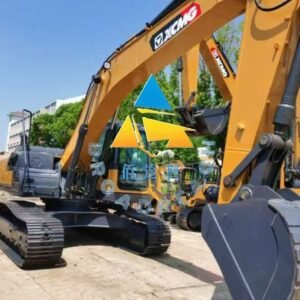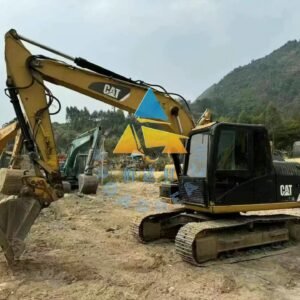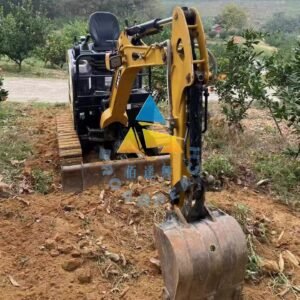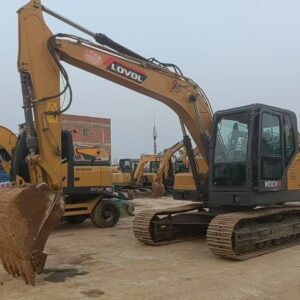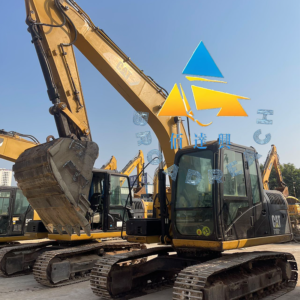BroadReach Construction Machinery Co., Ltd

The Value and Maintenance of Second-Hand Construction Machinery
In the construction industry, where heavy machinery plays a pivotal role, businesses often weigh the benefits of purchasing new versus second-hand equipment. Second-hand construction machinery offers significant cost savings and can be a viable option for companies looking to expand their fleets without the hefty price tag of new machinery. However, operating and maintaining second-hand equipment comes with its own set of challenges and considerations. This essay explores the experience of using second-hand construction machinery, along with essential maintenance practices to ensure longevity and optimal performance.
Why Choose Second-Hand Construction Machinery?
One of the primary reasons many companies opt for second-hand construction machinery is cost savings. The depreciation of heavy equipment is steep during its initial years, making used machinery considerably cheaper than new models. For small to medium-sized construction firms, this price difference can translate into significant capital savings, allowing them to allocate resources to other critical areas of the business.
Second-hand machinery also has the advantage of availability. Often, new models of heavy equipment have long lead times, especially for specialized machinery. On the other hand, used equipment is readily available in the market, providing immediate solutions to companies needing quick expansions or replacements.
In addition to affordability and availability, the availability of second-hand machinery offers proven reliability. When purchasing a second-hand machine, potential buyers can assess its historical performance, real-world usage, and any recurring issues that may have surfaced over time. This provides transparency and helps buyers make informed decisions based on the machine’s track record.
Challenges of Using Second-Hand Machinery
While second-hand construction machinery is cost-effective, it requires careful consideration and scrutiny. The performance and condition of used equipment vary greatly depending on how it was previously maintained. Poorly maintained machines can lead to frequent breakdowns, reduced performance, and, in some cases, safety hazards.
The absence of warranties for second-hand machinery is another challenge. New equipment typically comes with a manufacturer’s warranty, providing buyers with peace of mind and protection against unforeseen mechanical failures. In contrast, second-hand machines usually do not have this safety net, meaning that buyers must be prepared to cover repair costs out-of-pocket.
Another potential challenge with second-hand equipment is compatibility with modern technology. As technology advances, newer models often come equipped with advanced features, such as GPS systems, automated controls, and improved fuel efficiency. Older machines, especially those that have been used for many years, may not include these enhancements, potentially reducing productivity or increasing operational costs in the long run.
Despite these challenges, proper maintenance practices can significantly extend the lifespan and performance of second-hand machinery, making it a valuable asset for construction businesses.
Best Practices for Maintenance
1. Regular Inspections and Preventative Maintenance
Routine inspections are the foundation of a solid maintenance plan. For second-hand machinery, it is crucial to conduct detailed inspections before purchase and throughout its lifespan. Daily checks should include monitoring fluid levels (oil, coolant, hydraulic fluids), inspecting the tires or tracks, and ensuring that all controls are responsive.
Preventative maintenance schedules should be adhered to strictly. This includes regular oil changes, filter replacements, and lubrication of moving parts. Even though second-hand machines have already been in service, maintaining a proactive approach can help catch potential issues before they become major problems.
2. Keep Detailed Maintenance Records
One of the most valuable assets when managing second-hand construction machinery is a comprehensive maintenance log. Keeping a record of all repairs, parts replacements, and regular servicing helps track the machine’s performance over time. This information can be valuable not only for ensuring proper care but also for future resale value. Buyers of second-hand machinery are often more confident in purchasing equipment with a clear maintenance history.
3. Utilize OEM (Original Equipment Manufacturer) Parts
When it comes to repairs and replacements, using original equipment manufacturer (OEM) parts is essential. OEM parts are designed to meet the exact specifications of the machinery, ensuring a proper fit and function. While aftermarket parts may be cheaper, they can lead to premature wear and may not provide the same level of reliability. Given the already used nature of second-hand machinery, it is critical to invest in high-quality parts to maintain its performance.
4. Monitor Wear and Tear on Key Components
Construction machinery, especially those used for heavy-duty tasks, experiences considerable wear and tear. For second-hand equipment, it is important to monitor key components closely. Hydraulic systems, engines, transmission systems, and undercarriages should be regularly inspected for signs of wear. For instance, abnormal noises, vibrations, or leaks can indicate the need for immediate attention.
For machines with hydraulic systems, check hoses and seals for cracks, leaks, or brittleness. Keeping the hydraulic system in good condition can prevent costly breakdowns and ensure smooth operation of the machinery.
5. Fluid Management and Analysis
Fluids such as engine oil, hydraulic fluid, and transmission fluid play a crucial role in the performance and longevity of construction machinery. For second-hand equipment, regular fluid analysis can provide insights into the health of the machine. Fluid analysis helps identify contamination, wear metals, and other signs of internal component degradation.
By sending fluid samples to a laboratory for testing, operators can catch early warning signs of wear and take preventive actions before a breakdown occurs. This proactive approach can save thousands of dollars in repairs and downtime.
6. Focus on Operator Training
Even with a well-maintained machine, improper operation can lead to unnecessary wear and tear. Training operators to handle machinery correctly is an often-overlooked aspect of maintenance. Ensuring that operators are familiar with the machine’s capabilities and limitations can reduce the risk of misuse, accidents, and damage.
For second-hand machinery, it is especially important for operators to understand any quirks or unique features the machine may have, particularly if the equipment is an older model with outdated controls or systems.
7. Develop a Spare Parts Inventory
Having critical spare parts on hand can minimize downtime in the event of a breakdown. Since second-hand machinery may have components that are prone to wear or failure, keeping a stock of essential parts—such as filters, belts, and hydraulic hoses—can help ensure quick repairs when needed. This is particularly important for older models, where parts may be harder to find or take longer to ship.
Conclusion
Second-hand construction machinery offers tremendous value to construction companies, providing cost savings, immediate availability, and reliable performance when properly maintained. However, operating used equipment requires a proactive approach to maintenance and careful management to ensure its longevity. Regular inspections, fluid analysis, proper operator training, and the use of OEM parts are all key components of an effective maintenance strategy. By following these best practices, businesses can maximize the lifespan of their second-hand machinery and continue to operate efficiently in a competitive industry.


